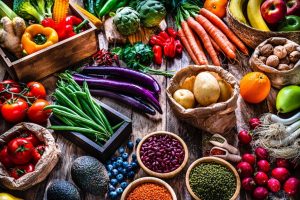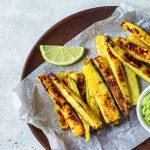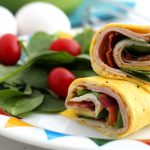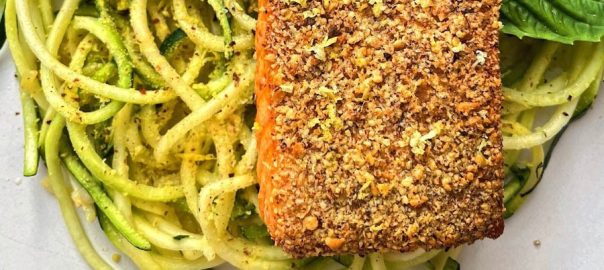
Nut Crusted Lemon Pepper Salmon
Lemon Pepper Nut Crusted Salmon with Zucchini Noodles
Learn how to make a complete low carb keto-friendly weeknight dinner made with Appel Food Nut Crumbs, omega-3 rich salmon, and a low carb pasta alternative!
In this article, we will be showing you how to make this simple yet flavourful low carb meal. It’s one of our go-to weeknight dinner recipes since it can be made in under 30 minutes, with very little prep work or cooking involved. Plus, it checks all of our boxes for a healthy, satisfying low carb meal! Also, stay tuned until the end of this article for a special reader incentive.
Disclaimer: The information in this article is not intended to replace personalized medical advice. A low carb diet may not be suitable for you. Consult your health care provider before making any changes to your lifestyle or use this information at your own risk.
A Bit About This Recipe…
We absolutely love this recipe for several reasons. First, it is suitable for a variety of specialty diets and is totally family friendly. This meal is gluten-free, grain-free, Paleo, pescatarian, and low in net and total carbohydrates. Secondly, it is made entirely from whole food ingredients and harnesses the power of nutrient-rich nuts to create delicious flavour and texture.
When planning your diet, it is helpful to think about what you want from your meals. Ideally, each of your meals throughout the day will include a source of healthy fats, protein, fibre and lots of vitamin and mineral-rich ingredients. This will keep you feeling full and energized and help stave off cravings. Regardless of the type of diet you follow – low carb, keto, paleo, gluten-free, vegan or other – these components are universal for good nutrition!
Let’s dive into each of these elements briefly to see why they are so important:
- Healthy omega-3 fatty acids.
The average Western diet is not particularly high in omega-3 fatty acids, yet these types of lipids are essential to good heart health and cognitive function. Perhaps it’s no coincidence that heart disease and Alzheimer’s/dementia are so prevalent in North America. Diets that include a lot of refined starches and sugars, such as the standard Western diet, are high in inflammatory compounds that contribute towards these diseases and damage our bodies over time.
By ensuring that we consume omega-3 fatty acids regularly and limit our intake of omega-6 fatty acids (found in refined carbohydrates, especially processed and packaged foods), we can reduce our risk for heart and brain disease. These fatty acids reduce inflammation in the blood vessels and help prevent plaque buildup, which is the main cause of heart attacks, stroke, and other cardiovascular disease. Plus, with clear pathways from our heart to our brain and other organs, our bodies can transport nutrients efficiently throughout the body and we can get to feeling our best selves. A healthy heart and a healthy mind are fundamental to healthy living.
So, you might be wondering – which foods are high in omega-3 fatty acids? Here’s a list of some of our favourite plant-based sources (high in ALA fatty acids) and animal sources (high in EPA and DHA fatty acids). Be sure to include one or more of these foods in all of your meals each day:
- Chia seeds
- Flax seeds or Flax oil (great for drizzling over salads)
- Hemp seeds
- Walnuts
- Extra virgin olive oil
- Grass-fed butter or Ghee
- Salmon (canned or fresh)
- Mackerel
- Anchovies and Sardines
- Oysters
- Omega-3 enriched Eggs
- Soybeans and Tofu
- Brussels sprouts
- Kale
- Spinach
- Broccoli
- Cauliflower
- Seaweed, nori, spirulina, and chlorella (algae) – great vegan sources of DHA and EPA!
- Micronutrients
Micronutrients, AKA vitamins and minerals, are the critical components needed by the body to fuel biochemical reactions inside cells. We have over 37 trillion cells in our body and each one requires certain vitamins and/or minerals to carry out their specific function. With over 200 types of cells with different functions – from converting our food into usable energy or regulating hormones throughout the day to repairing damaged cells and removing waste from the body – there are a variety of vitamins and minerals that we need to get from our diets to support these functions.
When we are lacking in certain micronutrients in the short term, it can lead to cravings for certain foods that may contain those vitamins and/or minerals. Long-term nutrient deficiencies can cause serious health conditions such as anemia (iron deficiency), vision loss (vitamin A deficiency), osteoporosis (calcium deficiency), fatigue and weakness (magnesium deficiency) – the list goes on[*].
Taking a daily multivitamin can help ensure you are getting the baseline level of required micronutrients, but consuming a diet rich in whole, unprocessed foods grown in healthy soil is ultimately the best way to maintain healthy and adequate micronutrient levels.
How to Get Enough Micronutrients in your Diet
There are several vitamins and minerals that our bodies need to function, and it can get nit-picky to keep track of each and every one of them. Plus, our bodies work best when we have all of the micronutrients we need, not just any specific one or few.
The easiest and best way to ensure you are getting the full spectrum of micronutrients that you need from your diet is to eat the rainbow! You may have heard this phrase before, and essentially, it refers to the different colours of fruits and vegetables that contain corresponding micronutrients. This is perhaps nature’s clever way of helping us humans and other animals obtain the necessary vitamins and minerals in our diets since fruits and vegetables come in such a wide array of appealing colours! Here’s what we’re talking about:
Red fruits and vegetables are high in anti-inflammatory compounds that may help prevent heart disease, cancer, and sun-related skin damage.
Dark red fruits and vegetables support healthy blood pressure and efficient oxygen uptake. They are great for improving athletic performance!
Yellow and orange fruits and vegetables support eye health as well as lower the risk of heart disease and cancer.
Green vegetables and fruits are very high in antioxidants that support gut, heart, and brain health.
Purple and “blue” fruits and vegetables are great for improving brain health and can lower the risk of developing type 2 diabetes and cancer.
White and brown fruits and vegetables support our immune system, gut health, and metabolism and may lower the risk of certain cancers.
- Fibre
Getting enough fibre in your day is essential not only for healthy blood sugar levels and good digestion, but it also means you’re getting enough vegetables and fruits in. Vegetables and fruits are high in both fibre and micronutrients, although you may only want to eat fruits in moderation if you follow a low carb diet.
Some fruits you can eat while keeping yourself in ketosis include berries, cherries, pears, apples and grapefruits or the juice of lemons and limes. If you’re watching your blood glucose levels, be sure to consume these in small amounts as having too much at once could spike your blood sugar. Consuming whole versions of fruits and vegetables including the skins/peels where applicable, as opposed to just the juice or concentrates found in many processed foods, also increases the fibre content of your meal or snack.
Does Fibre Count Towards Net Carbs?
Fibre is technically a carbohydrate, which is why you will see it listed under the carbohydrates section on nutrition facts tables. However, it has no effect on blood sugar levels and essentially passes through the digestive system “unrecognized” by the body, so it does not count towards your net carbohydrates. It might sound strange to consume something that is not absorbed by our bodies – but that’s exactly the point! Soluble and insoluble fibre absorbs water from our digestive tract and adds bulk to our meals, respectively, keeping us full and helping other macronutrients pass through the digestive tract. You can ensure you are getting both kinds of fibre by consuming a variety of vegetables, fruits, nuts, seeds and legumes or whole grains, if they are part of your diet.
- Protein
Finally, protein provides energy for our cells. It also helps keeps us full and is important if we want to maintain a healthy, lean body composition. Plus, if you are a frequent exerciser, you’ll need protein to replenish lost stores of energy from your muscles. Or, if you’re trying to improve your exercise regimen but just can’t find the energy, try increasing your protein intake!
Protein is only included in moderate amounts (about 20-25% of your daily calories) on a standard ketogenic diet. This is because excessive amounts of protein can get converted into glucose, which could throw you out of ketosis. That said, be sure that you are getting this recommended amount of protein, so you have enough energy and feel satisfied after meals!
Bringing It All Home…
To keep things simple, try to include nuts or seeds, a variety of fruits or vegetables, and a protein source (meat, eggs, tofu, or dairy) at each of your meals. This will help you stay full and energized throughout the day, promote healthy blood sugar levels, and help you ultimately achieve good health and longevity!
The recipe we’re about to show you is just one example of a dish that achieves everything we ideally want from our meals. So, let’s dive in!
Lemon Pepper Nut Crusted Salmon with Zucchini Noodles
Prep Time: 5 minutes
Cook Time: 15-20 minutes for the Salmon + 5 minutes for the Zucchini Noodles
Serves: 1
Like we mentioned, this recipe contains all of the things we want from a meal:
- Omega-3 Fatty Acids from wild-caught salmon, Nut Crumbs, and extra virgin olive oil
- Micronutrients contained in zucchini and Nut Crumbs
- Fibre from zucchini and Nut Crumbs
- Protein from salmon and Nut Crumbs
This meal also has a good macronutrient ratio, if you are looking for a keto-compliant lunch or dinner recipe.
Ingredients:
- 2kg of wild-caught salmon
- 2 cups of spiralized zucchini noodles
- 1-2 tablespoons of Appel Foods Nut Crumbs
- Juice + optional zest of ½ a lemon
- 1 clove of garlic, minced
- Salt and pepper to taste
- Extra virgin olive oil for cooking à Learn more about the best cooking oils to use on our blog! You can also substitute coconut oil or avocado oil if you have these on hand.
Cooking Instructions:
- Preheat your oven to 400˚F.
- On a baking sheet lined with parchment paper, lay out your salmon filet. Evenly coat the salmon in extra virgin olive oil. Then, add about 1-2 tablespoons of Appel Foods Lemon Pepper Nut Crumbs to form an even crust layer. Optional: Drizzle or spray additional cooking oil to help the crust crisp up even more.
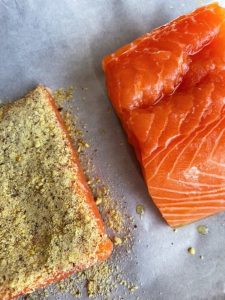
- Place the salmon in the oven and roast for approximately 20 minutes, depending on the thickness of your filet. Switching the oven to the Convection Roast setting for the last half of the cooking time will help the nut crust turn nice and golden brown!The salmon is finished cooking when it appears opaque or reaches an internal temperature of 145˚F.
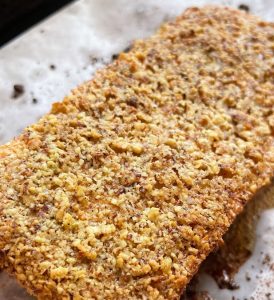
While the salmon is cooking, make your zucchini noodles:
- Heat a non-stick skillet over medium heat. While it is heating up, add about 1 tablespoon of extra virgin olive oil and the minced garlic to the pan. Stir the garlic for 1-2 minutes until slightly brown. Add cracked black pepper and stir some more.
- Add the zucchini noodles next and reduce the heat to low.
- Sauté the zucchini noodles for 1-2 minutes, just long enough to tenderize them. Be sure to stir frequently so the noodles don’t stick to the pan or burn. Add a squeeze of lemon juice to help the noodles soften and season with salt to taste just before removing from the heat.
- Serve the noodles on a plate with an extra sprinkle of Appel Foods Nut Crumbs, then top with your salmon and enjoy!
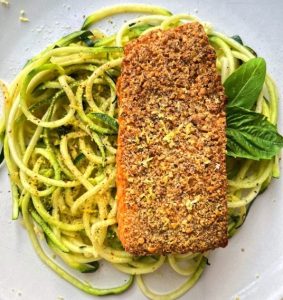
This recipe is so simple and quick to make that anyone can make it – even if you’re no expert in the kitchen! Thanks to Appel Foods Nut Crumbs, the salmon has a restaurant-quality crust that is full of flavour, texture, and healthy fats. The zucchini noodles are a perfect (dare we say superior?) low carb substitute to traditional pasta noodles, and they require almost no cooking time. This dish is sure to impress in terms of flavour and presentation with almost no effort required. Try it out next time you are planning family dinners or having guests over, we guarantee you (and they) won’t be disappointed!
Stay Connected
We hope that this article was helpful and gave you some low carb cooking inspiration. If you try this recipe at home, please share your results with us on Facebook or Instagram by tagging us @lowcarbgrocery and @nutcrumbs! We love to see our products in action and enjoyed by our customers.
We’d also love to hear your feedback with a Google Review. And, remember to sign up to our email newsletter to be the first to know about The Low Carb Grocery’s weekly sales and top keto, low-carb, and sugar-free trends and recipes!





